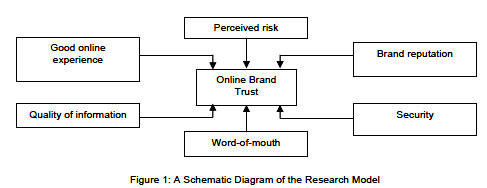Introduction
In the contemporary society majority of consumers usually turn to internet for various shopping needs. Such process is referred to as online shopping. This concept contributes towards opening of e-business opportunities within international market, enabling consumers to access and purchase wide range of goods and services from any location.
The process is made possible since search engines and delivery services are efficiently available (Keegan and Green, 2002). However, such decisions are most of the time influenced by level of trust consumers have on particular online brands.
Analysis of Online Trust Brand
Several barriers are associated with online shopping some of which include security of search engines, privacy as well as level of trust. Online trend has brought complete changes within businesses based on various distribution channels utilized.
According to Keegan and Green (2002), international marketing involves processes where companies define goals and objectives based on extensive investments on resources within various market segments.
In such cases, companies focus on effective marketing strategies capable of utilizing current technological wave brought by internet. The process is of great benefit to consumers based on costs, since they no longer need to scramble for parking spaces at shopping malls (Ha, 2004).
Research has been done on online brand trust based on consumer interests within textile products market. Online transactions can only be complete in the event that there is existing trust between customers and company’s brand. This makes online brand trust to be very important concept since it assists in creation of favourable attitude towards suppliers (Goodwin, 1996).
At the same time, it helps in prolonging exchange relationships and increases competitiveness hence making trustworthy brands gain competitive advantage. The process is much related to online trust which presents important business models in business-to-business transactions. Moreover, many challenges are encountered in the process of establishing and maintaining online trust.
This makes majority of companies to be cautious when dealing with online clients. In a similar case online consumers feel reluctant to trade online since they do not trust most web providers with their personal information. This presents online brands with responsibility of establishing some level of trust with customers for the purposes of transacting businesses (Xiling, 2005).
Factors influencing online Brand Trust

Factors influencing online brand trust are shown in the above diagram. Brand trust is used to refer to the kind of trust consumer attaches to specific brands. This assists in establishment of long-term relationship based on benefits and qualities obtained through delivery processes.
Additionally, brand trust enables easier development of consumer’s commitment towards such online products as variety of shoes and clothing offered by Zappos Company. In the same line, Zappos.com brand extensions provide consumers with variety of options making it possible for customers to share information concerning their preferences, tastes and behaviours (Ha, 2004).
One of the most important aspects of brand trust is based on its reliability. This is because brand trust involves technical capabilities vital for satisfaction of consumer desires. Moreover, there are certain attributes which usually attract consumer interests hence granting confidence to consumers amidst uncertainties with range of products.
Additionally, presence of value should be felt by consumers on the range of products offered based on development process, line of sales used and even in nature of advertisement. Despite many advantages, online brand trust operates in relation to some crucial purchase related factors which determines ultimate outcome.
These include; status of security, privacy on personal details, and nature of information conveyed as well as past experiences. Word-of-mouth is one of the most known purchase-related factors used in building consumer trust.
At the same time, factors affecting online brand trust can be categorized as web-site and consumer factors which apparently are related to various components of trust such as credibility of website and quality based on emotional comfort (Ha, 2004).
Drivers of Online Brand Trust
Free Shipping and Free returns offer
Zappos.com grants customers free shipping on all domestic orders transacted through their website. This gives consumer’s confidence with the company since they are not charged extra fee irrespective of order sizes. All purchased products are delivered within recommendable time-line, 4 to 5 business days. At the same time customers are allowed to return goods to warehouse in case of dissatisfaction.

Reliability Based on PayPal, Visa Cards and Master Card
PayPal provides one of the most reliable e-money services since it offers extra protection for users. Allowing use of PayPal by Zappos.com offers some level of security to customers especially on goods purchased. Refunds are processed for the goods and the original cost of postage. Use of Visa and MasterCard provides customers with opportunity to raise a ‘chargeback’ in-case purchases are interfered with.

Customer Services on Live chat
Allowing consumers to contact Zappos.com customer care services via live chat encourages general expectancy on products. Such free interaction helps in reinforcing belief on brand qualities which makes the company appear competent and responsible for every provision within the website.
Dispositional attributes determines consumers’ intentions and behaviour towards product quality making it mandatory for Zappos to identify various attributions forming brand trust. The idea of trust assists in bridging the gap between determinants and consumer reactions towards product attributes (Ha, 2004).
Low level of online purchases can be attributed to lack of trust between consumers and companies. Dayal et al (1999), focuses on the security issues, merchant legitimacy as well as fulfilment on some of the most important factors influencing online trust.
At the same time Shankar et al. (2002) made differentiations by applying unique characteristics on online brand trust which incorporates distinctive constructs such as page design characteristics and consumer characteristics.
Additionally, there is inclusion of crucial characteristics such as application of appropriate online medium, level of consumer confidence towards the firm, various brand qualities based on firm’s size, performance within the market as well as communication mix.

Consumer’s perceived risk
The nature of consumer’s perceived risk may affect brand trust since it originates from economic and performance risks. Customers are capable of anticipating the kind of monetary loss they would incur in the process of transacting purchases online.
At times they risk in terms of performances whereby the kind of products shown in the Zappos website do not meet their expectations as shown in the website pictures. Such perceived risk affects negatively the level of trust on particular brands (Salo and Karjaluoto, 2007).
Website Quality
Online brand trust of Zappos Company has got highly visible nature of advertising which plays major role in the development of company’s brand image.
The kind of messages used, including consumer comments conveys strong messages towards clothes, shoes and handbags based on functional abilities while at the same time brands accompanied by aesthetic meaningful values portrays some level of relevance to online purchasers (Hofmeyr, 2001). Evidently, there are pop-up adverts within the website accompanying products.
This helps in reinforcing brand image since communication through company websites influences strong brand memories which ultimately can be linked to consumers’ past experiences with specified products (Hofmeyr, 2001).

Such memories passes through the mind in line with real structuring which enables real interactions between consumers and products based on expectation levels. Online brand trust is basically action oriented with more appealing decorations of which at times can deceive online buyers.
Level of brand trust determines how fast brand images fade from minds of consumers since it is dependent on competitive nature and functions of other related products. Most consumers are normally inclined towards nature of information accompanying products inclusive of price tags (Hofmeyr, 2001).
The nature of display incorporates all the four P’s of marketing which includes identification of various prices and discounts attached suitable buyers and target markets (Ha, 2004). The level of online brand trust reveals the level of achievement attained by the current branding technique used by the company.
Conclusion
Well-designed company websites usually provides potential capabilities in conveying timely information to online purchasers. This provides intended satisfaction levels hence reinforcing brand online trust. Quality information helps in increasing consumer knowledge and awareness concerning online products making it easier for them to make concrete decisions concerning brands.
At the same time online brand trust is based on product reputation whereby consumer’s level of trust is based upon level of brand reputation within the market. However, understanding consumer perceptions based on online brand trust proves a little difficult task capable of creating challenging situations to retailers hence the need for effective e-marketing strategies. Recommendations
Strategies implemented on the website seem important since the target market is defined based on the shoe and clothes sizes. This should basically be based upon identification of relevant market segments based on age, preferences and social classes. Planning done concerning various marketing strategies should basically be aimed at improving level of organizational performance which would ultimately yield higher returns.
Process of organizing brands used in e-business involves great allocation of resources for the purposes of attracting grater traffic based on satisfied needs. In the case of Zappos brands, the nature of plan used on the site assists only in the identification and fulfilment of various consumer desires.
Moreover, the process of posting customer comments alongside brands creates strong desire within other buyers willing to try same products.
Such comments create referral opportunities since they are always convincing based on the rating, which at times reflects true level of consumer satisfaction based on quality and expectations. Additionally, Zappos.co should create a bar on the top to ensure that customer’s country base appear first during search process.
Reference List
Dayal, S, Landesberg, H & Zeisser, M 1999, How to Build Trust Online, Marketing Management, Fall, London
Goodwin, R 1996, Economic Meanings of Trust and Responsibility, The University of Michigan Press: Ann Arbor, MI,
Ha, H 2004, “Factors influencing consumer perceptions of brand trust online,” Journal of Product & Brand Management, vol. 13, no. 5, pp. 329-342
Hofmeyr, J 1990, The Conversion Model – A new foundation for Strategic Planning in Marketing, EMAC/ESOMAR conference, Athens.
Keegan, M & Green, K 2002, Global marketing management, NY: Prentice hall
Salo, J & Karjaluoto, H 2007, “A conceptual model of trust in the online environment,” Online Information Review, Vol. 3, no. 5, pp. 604-609
Shankar, F, Sultan, G, Urban, L & Bart, I 2002, The Role of Trust in online Customer Support, Working Paper, Sloan School of Management, MIT, Cambridge,
Xiling, Z & Xiangchun, L 2005, Effective user interface design for consumer trust: Two case studies, Unpublished, M.S. thesis, Lulea University of Technology, Lulea.